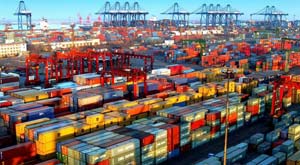China highly likely to top trade in goods
China Daily, February 10, 2014 Adjust font size:
At home, the regional structure of exports was also given priority, with central and western regions accounting for 15.5 percent of China's exports last year, compared with 10.3 percent five years ago. The share of exports by private businesses, which reflects the vitality of China's exports, was 41.5 percent last year, compared with 26.8 percent five years ago.
In addition, the structure of Chinese exports has changed, high-tech accounting for 29.9 percent last year, compared with 29 percent in 2008. Last year, high-tech exports were worth $660.34 billion, an increase of 9.8 percent year-on-year. Exports of mechanical and electrical products were worth $1.27 trillion, an increase of 7.3 percent year-on-year, that represented about 57.3 percent of the country's overall exports, Shen said.
The share of general trade, as opposed to the processing trade — in which parts or raw materials are imported then re-exported as finished products once Chinese businesses process or assemble them — rose to 52.8 percent of all trade last year, compared with 48.2 percent in 2008, he says. The processing trade accounted for 32.6 percent of overall trade last year, down from 41.1 percent in 2008.
"Although China is now a leading goods trader, there is still a long way to go for it to turn from a large goods trader into a strong goods trader," Shen said.
China's export business remains on the medium- and low-end of global industrial chains and has limited technology and value added. Challenges also include rising costs, appreciation of the renminbi and orders shifting to emerging economies, Shen said.
However, the ministry is cautiously optimistic about the country's trade prospects, he said. "It's hard to say exactly what growth will be this year, but it is unlikely to be higher than last year."
In trade figures in the first quarter of this year there are likely to be fluctuations because of rising costs, a shortage of capital, fierce competition and foreign trade figures in the corresponding period last year that are widely believed to have been overstated as the result of speculative capital inflow disguised as trade payments.
"The global economy is recovering, but the momentum is not solid," Shen said. "Costs keep rising at home, challenging small and medium-sized enterprises in particular. Competition is stiffening globally. Orders are drying up as developed economies encourage their overseas businesses to repatriate and Southeast Asian countries win more orders because of their lower costs compared with China."
Zheng, the customs administration spokesman, is also keenly aware of the challenges China's foreign trade faces this year. "Foreign direct investment in Chinese manufacturing fell last year, suggesting weakened momentum in the country's exports in the near future. Processing trade imports rose 3.3 percent last year compared with the previous year, indicating that prospects for processing trade imports in the near term do not look bright."


